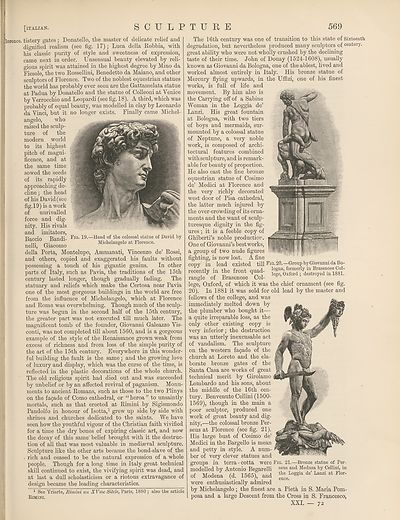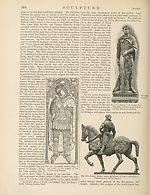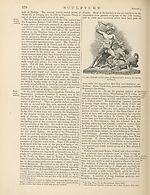Encyclopaedia Britannica > Volume 21, ROT-Siam
(579) Page 569
Download files
Complete book:
Individual page:
Thumbnail gallery: Grid view | List view

[ITALIAN.
SCULPTURE
569
Fig. 19.—Head of the colossal statue of David by
Michelangelo at Florence,
Florence, tistery gates ; Donatello, the master of delicate relief and
dignified realism (see fig. 17); Luca della Robbia, with
his classic purity of style and sweetness of expression,
came next in order. Unsensual beauty elevated by reli¬
gious spirit was attained in the highest degree by Mino da
Fiesole, the two Rossellini, Benedetto da Maiano, and other
sculptors of Florence. Two of the noblest equestrian statues
the world has probably ever seen are the Gattamelata statue
at Padua by Donatello and the statue of Colleoni at Venice
by Verrocchio and Leopardi (see fig. 18). A third, which was
probably of equal beauty, was modelled in clay by Leonardo
da Vinci, but it no longer exists. Finally came Michel¬
angelo, who
raised the sculp¬
ture of the
modern world
to its highest
pitch of magni¬
ficence, and at
the same time
sowed the seeds
of its rapidly
approaching de¬
cline ; the head
of his David (see
fig. 19) is a work
of unrivalled
force and dig¬
nity. His rivals
and imitators,
Baccio Bandi-
nelli, Giacomo
della Porta, Montelupo, Ammanati, Vincenzo de’ Rossi,
and others, copied and exaggerated his faults without
possessing a touch of his gigantic genius. In other
parts of Italy, such as Pavia, the traditions of the 15th
century lasted longer, though gradually fading. The
statuary and reliefs which make the Certosa near Pavia
one of the most gorgeous buildings in the world are free
from the influence of Michelangelo, which at Florence
and Rome was overwhelming. Though much of the sculp¬
ture was begun in the second half of the 15th century,
the greater part was not executed till much later. The
magnificent tomb of the founder, Giovanni Galeazzo Vis¬
conti, was not completed till about 1560, and is a gorgeous
example of the style of the Renaissance grown weak from
excess of richness and from loss of the simple purity of
the art of the 15th century. Everywhere in this wonder¬
ful building the fault is the same; and the growing love
of luxury and display, which was the curse of the time, is
reflected in the plastic decorations of the whole church.
The old religious spirit had died out and was succeeded
by unbelief or by an affected revival of paganism. Monu¬
ments to ancient Romans, such as those to the two Plinys
on the fagade of Como cathedral, or “ heroa ” to unsaintly
mortals, such as that erected at Rimini by Sigismondo
Pandolfo in honour of Isotta,1 grew up side by side with
shrines and churches dedicated to the saints. We have
seen how the youthful vigour of the Christian faith vivified
for a time the dry bones of expiring classic art, and now
the decay of this same belief brought with it the destruc¬
tion of all that was most valuable in mediaeval sculpture.
Sculpture like the other arts became the bond-slave of the
rich and ceased to be the natural expression of a whole
people. Though for a long time in Italy great technical
skill continued to exist, the vivifying spirit was dead, and
at last a dull scholasticism or a riotous extravagance of
design became the leading characteristics.
1 See Yriarte, Rimini au XVme Siecle, Paris, 1880 ; also the article
Rimini.
The 16 th century was one of transition to this state of Sixteenth
degradation, but nevertheless produced many sculptors of century,
great ability who were not wholly crushed by the declining
taste of their time. John of Douay (1524-1608), usually
known as Giovanni da Bologna, one of the ablest, lived and
worked almost entirely in Italy. His bronze statue of
Mercury flying upwards, in the Uffizi, one of his finest
works, is full of life and
movement. By him also is
the Carrying off of a Sabine
Woman in the Loggia de’
Lanzi. His great fountain
at Bologna, with two tiers
of boys and mermaids, sur¬
mounted by a colossal statue
of Neptune, a very noble
work, is composed of archi¬
tectural features combined
with sculpture, and is remark¬
able for beauty of proportion.
He also cast the fine bronze
equestrian statue of Cosimo
de’ Medici at Florence and
the very richly decorated
west door of Pisa cathedral,
the latter much injured by
the over-crowding of its orna¬
ments and the want of sculp¬
turesque dignity in the fig¬
ures ; it is a feeble copy of
Ghiberti’s noble production.
One of Giovanni’s best works,
a group of two nude figures
fighting, is now lost. A fine
copy in lead existed till 20.—Group by Giovanni da Bo-
recently in the front quad-
rangle of Brasenose Cof-
lege, Oxford, of which it was the chief ornament (see fig.
20). In 1881 it was sold for old lead by the master and
fellows of the college, and was
immediately melted down by
the plumber who bought it—
a quite irreparable loss, as the
only other existing copy is
very inferior; the destruction
was an utterly inexcusable act
of vandalism. The sculpture
on the western fagade of the
church at Loreto and the ela¬
borate bronze gates of the
Santa Casa are works of great
technical merit by Girolamo
Lombardo and his sons, about
the middle of the 16th cen¬
tury. Benvenuto Cellini (1500-
1569), though in the main a
poor sculptor, produced one
work of great beauty and dig¬
nity,—the colossal bronze Per¬
seus at Florence (see fig. 21).
His large bust of Cosimo de’
Medici in the Bargello is mean
and petty in style. A num¬
ber of very clever statues and
groups in terra-cotta were Fig. 21.—Bronze statue of Per-
modelled by Antonio Begarelli seus and Medu,sa Cellini-in
of Modena (d. 1565), and t^LoggM de La™ »t Flor-
were enthusiastically admired
by Michelangelo; the finest are a Pi eta in S. Maria Pom-
posa and a large Descent from the Cross in S. Francesco,
XXL — 72
SCULPTURE
569
Fig. 19.—Head of the colossal statue of David by
Michelangelo at Florence,
Florence, tistery gates ; Donatello, the master of delicate relief and
dignified realism (see fig. 17); Luca della Robbia, with
his classic purity of style and sweetness of expression,
came next in order. Unsensual beauty elevated by reli¬
gious spirit was attained in the highest degree by Mino da
Fiesole, the two Rossellini, Benedetto da Maiano, and other
sculptors of Florence. Two of the noblest equestrian statues
the world has probably ever seen are the Gattamelata statue
at Padua by Donatello and the statue of Colleoni at Venice
by Verrocchio and Leopardi (see fig. 18). A third, which was
probably of equal beauty, was modelled in clay by Leonardo
da Vinci, but it no longer exists. Finally came Michel¬
angelo, who
raised the sculp¬
ture of the
modern world
to its highest
pitch of magni¬
ficence, and at
the same time
sowed the seeds
of its rapidly
approaching de¬
cline ; the head
of his David (see
fig. 19) is a work
of unrivalled
force and dig¬
nity. His rivals
and imitators,
Baccio Bandi-
nelli, Giacomo
della Porta, Montelupo, Ammanati, Vincenzo de’ Rossi,
and others, copied and exaggerated his faults without
possessing a touch of his gigantic genius. In other
parts of Italy, such as Pavia, the traditions of the 15th
century lasted longer, though gradually fading. The
statuary and reliefs which make the Certosa near Pavia
one of the most gorgeous buildings in the world are free
from the influence of Michelangelo, which at Florence
and Rome was overwhelming. Though much of the sculp¬
ture was begun in the second half of the 15th century,
the greater part was not executed till much later. The
magnificent tomb of the founder, Giovanni Galeazzo Vis¬
conti, was not completed till about 1560, and is a gorgeous
example of the style of the Renaissance grown weak from
excess of richness and from loss of the simple purity of
the art of the 15th century. Everywhere in this wonder¬
ful building the fault is the same; and the growing love
of luxury and display, which was the curse of the time, is
reflected in the plastic decorations of the whole church.
The old religious spirit had died out and was succeeded
by unbelief or by an affected revival of paganism. Monu¬
ments to ancient Romans, such as those to the two Plinys
on the fagade of Como cathedral, or “ heroa ” to unsaintly
mortals, such as that erected at Rimini by Sigismondo
Pandolfo in honour of Isotta,1 grew up side by side with
shrines and churches dedicated to the saints. We have
seen how the youthful vigour of the Christian faith vivified
for a time the dry bones of expiring classic art, and now
the decay of this same belief brought with it the destruc¬
tion of all that was most valuable in mediaeval sculpture.
Sculpture like the other arts became the bond-slave of the
rich and ceased to be the natural expression of a whole
people. Though for a long time in Italy great technical
skill continued to exist, the vivifying spirit was dead, and
at last a dull scholasticism or a riotous extravagance of
design became the leading characteristics.
1 See Yriarte, Rimini au XVme Siecle, Paris, 1880 ; also the article
Rimini.
The 16 th century was one of transition to this state of Sixteenth
degradation, but nevertheless produced many sculptors of century,
great ability who were not wholly crushed by the declining
taste of their time. John of Douay (1524-1608), usually
known as Giovanni da Bologna, one of the ablest, lived and
worked almost entirely in Italy. His bronze statue of
Mercury flying upwards, in the Uffizi, one of his finest
works, is full of life and
movement. By him also is
the Carrying off of a Sabine
Woman in the Loggia de’
Lanzi. His great fountain
at Bologna, with two tiers
of boys and mermaids, sur¬
mounted by a colossal statue
of Neptune, a very noble
work, is composed of archi¬
tectural features combined
with sculpture, and is remark¬
able for beauty of proportion.
He also cast the fine bronze
equestrian statue of Cosimo
de’ Medici at Florence and
the very richly decorated
west door of Pisa cathedral,
the latter much injured by
the over-crowding of its orna¬
ments and the want of sculp¬
turesque dignity in the fig¬
ures ; it is a feeble copy of
Ghiberti’s noble production.
One of Giovanni’s best works,
a group of two nude figures
fighting, is now lost. A fine
copy in lead existed till 20.—Group by Giovanni da Bo-
recently in the front quad-
rangle of Brasenose Cof-
lege, Oxford, of which it was the chief ornament (see fig.
20). In 1881 it was sold for old lead by the master and
fellows of the college, and was
immediately melted down by
the plumber who bought it—
a quite irreparable loss, as the
only other existing copy is
very inferior; the destruction
was an utterly inexcusable act
of vandalism. The sculpture
on the western fagade of the
church at Loreto and the ela¬
borate bronze gates of the
Santa Casa are works of great
technical merit by Girolamo
Lombardo and his sons, about
the middle of the 16th cen¬
tury. Benvenuto Cellini (1500-
1569), though in the main a
poor sculptor, produced one
work of great beauty and dig¬
nity,—the colossal bronze Per¬
seus at Florence (see fig. 21).
His large bust of Cosimo de’
Medici in the Bargello is mean
and petty in style. A num¬
ber of very clever statues and
groups in terra-cotta were Fig. 21.—Bronze statue of Per-
modelled by Antonio Begarelli seus and Medu,sa Cellini-in
of Modena (d. 1565), and t^LoggM de La™ »t Flor-
were enthusiastically admired
by Michelangelo; the finest are a Pi eta in S. Maria Pom-
posa and a large Descent from the Cross in S. Francesco,
XXL — 72
Set display mode to:
![]() Universal Viewer |
Universal Viewer | ![]() Mirador |
Large image | Transcription
Mirador |
Large image | Transcription
Images and transcriptions on this page, including medium image downloads, may be used under the Creative Commons Attribution 4.0 International Licence unless otherwise stated. ![]()
| Encyclopaedia Britannica > Encyclopaedia Britannica > Volume 21, ROT-Siam > (579) Page 569 |
|---|
| Permanent URL | https://digital.nls.uk/193634806 |
|---|
| Attribution and copyright: |
|
|---|---|
| Shelfmark | EB.17 |
|---|---|
| Description | Ten editions of 'Encyclopaedia Britannica', issued from 1768-1903, in 231 volumes. Originally issued in 100 weekly parts (3 volumes) between 1768 and 1771 by publishers: Colin Macfarquhar and Andrew Bell (Edinburgh); editor: William Smellie: engraver: Andrew Bell. Expanded editions in the 19th century featured more volumes and contributions from leading experts in their fields. Managed and published in Edinburgh up to the 9th edition (25 volumes, from 1875-1889); the 10th edition (1902-1903) re-issued the 9th edition, with 11 supplementary volumes. |
|---|---|
| Additional NLS resources: |
|

